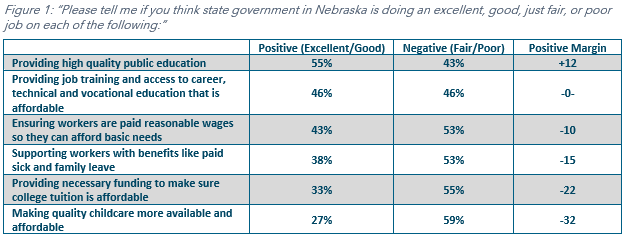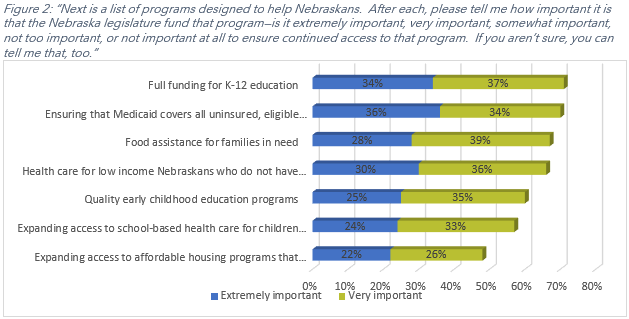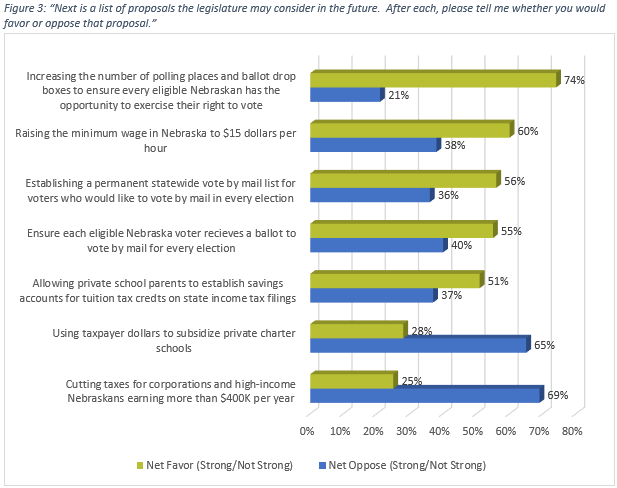Nebraska Voters’ Outlook is commissioned by and conducted in partnership with Patinkin Research Strategies, LLC March 16 – 21, 2022, among 620 registered voters across the state. Total results are available here. View the research memo here. View the press release here.
State and Elected Official Performance
Nebraskans lean narrowly “right direction” (47%) in terms of the direction of the state[1] with four-in-10 (42%) indicating that they believe things have gotten off on the “wrong track.” Majorities approve of both Governor Ricketts’ (54% approve; 40% disapprove) and the Nebraska state legislature’s (52% approve; 34% oppose) performance in office.
Nebraska voters assess failing grades on state performance in all but the provision of high-quality public education. As noted in Figure 1 below, these include access to paid sick and family leave (53% negative), ensuring workers are paid reasonable wages (53% negative), access to affordable childcare (59% negative) and ensuring access to affordable college tuition (55% negative).
1] Generally speaking, do you think things in Nebraska are moving in the right direction or do you feel things have gotten off on the wrong track?

In open-ended questioning,[1] 22% of surveyed Nebraskans feel state government is most focused on helping wealthy/rich Nebraskans, more than double the closest ranked priority. Another 10% feel the state is most focused on helping immigrants/minorities, and just under one-in-10 believe it is most focused on helping itself (7%), certain industries especially agriculture (6%) and the poor/homeless (6%). Priorities ranking the lowest among those perceived to benefit from state government action include helping middle-income families (4%) or average people/taxpayers (2%).
“Voters don’t believe state government delivers meaningful public policy results to average, working Nebraskans,” says Holland Children’s Institute CEO, Hadley Richters. “Negative perceptions of state performance on policies affecting children and families are an indictment of the state’s track record and should be lawmakers’ wake-up.”
Interestingly, despite narrow majority approval overall of the state’s direction as well as Governor Ricketts’ and State Legislature’s performance, significant majorities disapprove of performance on specific child and family-friendly policies. This divergence warrants further consideration of how and why incumbent state lawmakers win elected office (historically, with significant margins of support), despite lack of support for policies that consistently rank as important to Nebraskans.
[1] Which groups or people do you think state government is focused on helping the most?
Policy Priorities
When asked open-ended questions regarding Nebraska’s 2021 federally designated American Rescue Plan funding priorities, Nebraskans supported investment in health care (17%), K-12 schools (16%), affordable housing (16%) and one-time tax relief (16%).[1] Lesser priorities include small business job creation (12%), boosting availability of affordable child care (8%), and higher education (2%).
Asked about the perceived importance of legislative funding for state programs, respondents express clear and broad consensus on increasing access, particularly for children (70%) and low-income Nebraskans (66%) (See Figure 2 below).
[1] Changing gears, Congress and President Biden passed the American Rescue Plan in 2021 in order to help move the economy forward in the wake of the COVID-19 pandemic. With passage of this law, Nebraska has received one billion dollars in federal aid. Knowing this, which of the following do you think is most important for Nebraska to invest in?

Topping the list of funding priorities for Nebraska voters includes
“fully funding K-12 education” (71%) and “ensuring Medicaid covers all
uninsured, eligible Nebraska children” (70%). Among the lowest listed
priorities, “expanding access to school-based health care for children in need”
(57%), and “ensuring affordable housing” (48%). Despite importance to voters,
Nebraskans are dissatisfied with state government performance (see Figure 1 above).
“Voters understand funding high-quality public schools and children’s health care is closely linked to state success. That is consistent and well-reasoned. But they may be surprised to learn how their own state senators’ efforts proliferate legislative bills and state budgets which undermine these public priorities,” reasons Richters.
When asked further about popular policy proposals considered by Nebraska’s Legislature, respondents express robust support for increasing access to polling places and drop boxes (74% favor). Strong support also exists for a $15 minimum wage (see Figure 3 below). It’s also noteworthy to consider that support for a $15 minimum wage in Nebraska increased significantly over the past year (+16 since July 2021). A slim majority support tax credits for private school savings accounts (51%) while nearly two-thirds oppose both public funding of charter schools (65%) and cutting taxes for corporations and wealthy Nebraskans (69%).

Conclusion
“Despite voter priorities and favorable state economic conditions, there is little political will to take up policies so many Nebraskans value, and even less of the kind needed to pass them into law,” concludes Richters. “We have tried tax cuts and corporate incentive packages worth hundreds of millions of dollars, even building a lake rather than ensure a $15 minimum wage, paid leave, or full funding to K-12 public schools. Legislative priorities are out-of-step with Nebraska’s children and families.”
Whatever the results, it remains to be seen if Nebraska lawmakers seeking reelection to state offices will be forced to reckon with their refusal to pursue or deliver on public policy voter majorities deem important by strong margins. Narrow general favorability of state lawmakers and historical trends strongly favoring incumbent reelection suggest that most escape accountability at the ballot box and perpetuate a cycle of incongruence between voter priorities and lawmaker performance.
Methodology
The survey sample was randomly selected from TargetSmart’s enhanced voter file and quotas and weights were set based on education, age, gender, party registration, party identification, 2020 presidential vote choice, county, and race to reflect a statistically representative universe of registered voters in Nebraska. Weights and quotas specific to education (based on census data), party registration, party identification (avg. of the three past surveys), and 2020 presidential vote choice were set specifically to reduce the impact of differential non-response bias and ensure an accurate representation of more conservative Republican and independent voters based on numerous post-election 2020 analyses conducted by both Republican and Democratic polling firms. The multi-modal platform selected for this research project (the current gold standard in research design) was also implemented to minimize the impact of differential non-response bias.